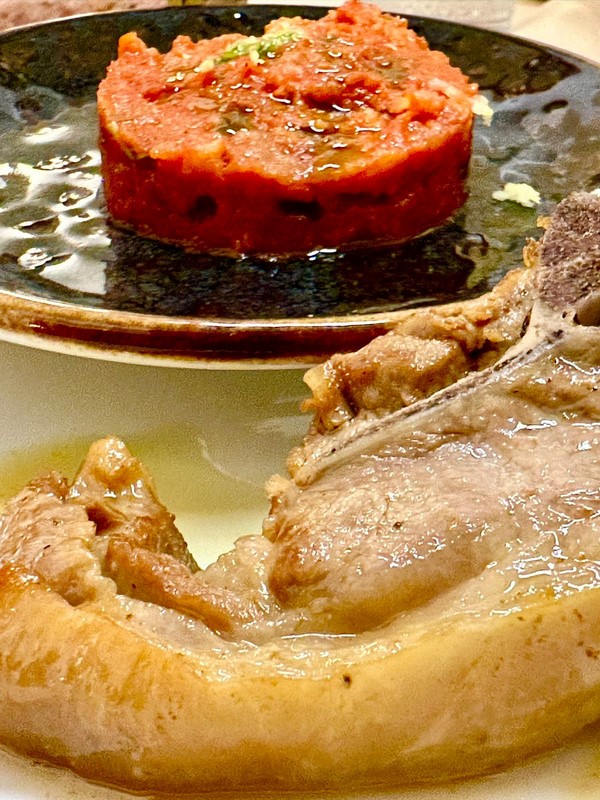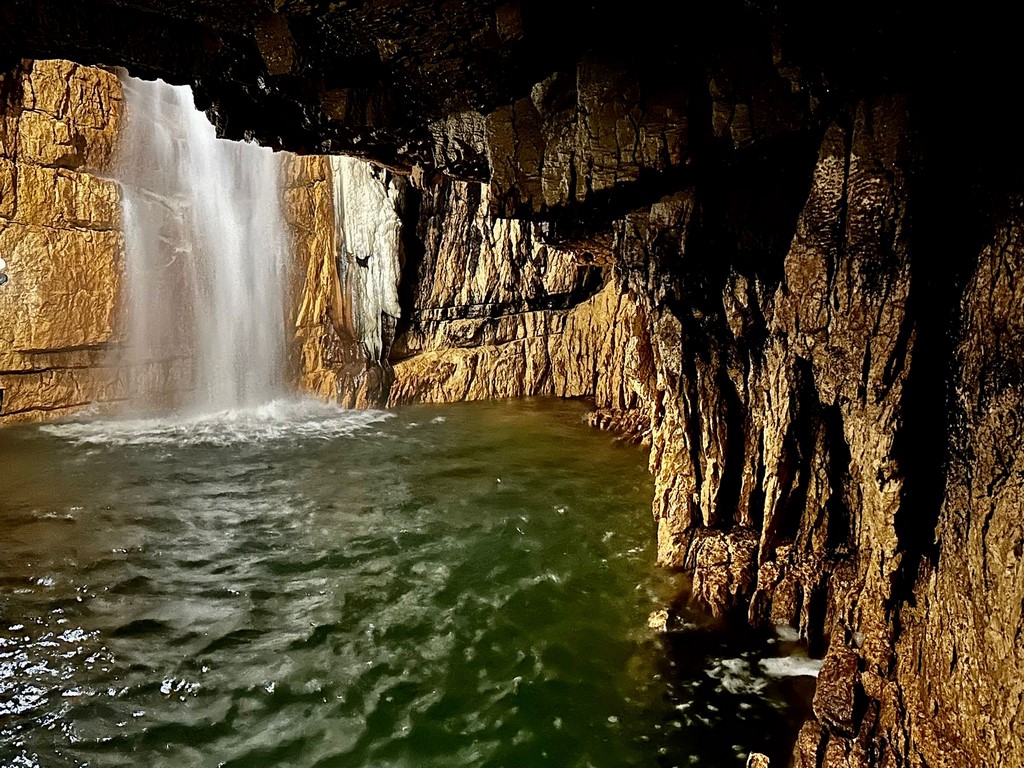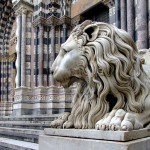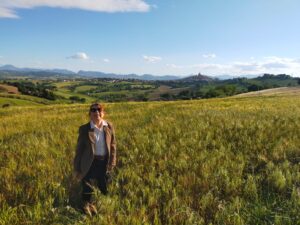Have you ever heard about carruggi?
Discovering L’Aquila: Past, Present, and Future
Slow-tour through the historic center, natural wonders, and Abruzzo’s cuisine.
by Silvia Salomoni
One thing you may not know about L’Aquila is that its historic center is the sixth largest in Italy, after only Rome, Naples, Venice, Florence, and Genoa. Beyond its size – 1.5 square km – it boasts a rich artistic and architectural heritage with 5.5 km of medieval walls still standing out of the original 11 km. Refounded in 1254, the city has a long history marked by significant seismic events, the latest of which in April 2009 we all remember. Because of this, it has been rebuilt several times, almost entirely after the devastating earthquake of 1703. Historically, it was one of the most important centers of the Kingdom of Naples, but at some point, the French Angevin rule passed to the Spanish Aragonese, not without conflict. Nonetheless, L’Aquila has never been part of the Papal State, staying close to yet separate from Rome. Today, the city is looking forward to 2026 when it will be the Italian Capital of Culture, and it is expected that all reconstruction goals will be achieved by then. Among these is the restoration of the National Museum of Abruzzo – known as MuNDA – to its original location at the Spanish Fort, leaving the temporary premises at the former slaughterhouse that have hosted the most significant items of the collection and that will soon… reunite with the Mammoth! What does that mean?

MuNDA and the Spanish Fort
While waiting to reopen to the public with the entire collection of the Museum, the Spanish Fort – which is not a castle but a fort, a military bastion that operated until the Nazi occupation – houses an incredible prehistoric find: the complete skeleton of a Mammoth! This fossil, 4 meters tall and 7 meters long, is truly unique in Europe, dating back to 1.3 million years ago and including 149 bones found in anatomical connection. It belongs to the species Meridionalis (which was hairless, unlike our idea of the woolly mammoth), extinct for over 800,000 years, and at the time of its death, it was 55 years old and weighed as much as 140 men. The skeleton was discovered 70 years ago at Madonna della Strada in Scoppito while working in a clay quarry only one meter deep. It was so well preserved due to the clay’s oxygen-poor environment. Our mammoth, which has been on public display since 1960, provides a look into Italy’s distant past, when Abruzzo had a climate similar to Africa, making it perfect for huge mammals.



The museum houses a large number of archeological artifacts, paintings, and sculptures from the Middle Ages to the present day, all relating to these areas. In the archaeological section, particularly important are the finds from the necropolises of Fossa and Bazzano (8th and 6th century BC) and the Amiternum Calendar, dating back to the Roman imperial era (1st century AD), which provides detailed information on the religious and civic practices of ancient Rome. Continuing through the exhibition, there are other works by Leonardo di Sabino that are noteworthy because they represent the transition from the late medieval Gothic period to a new humanism, which would later be completely articulated by Saturnino Gatti in the mid-15th century. An age when artists’ work was collaborative and closely related to that of artisans, as evidenced by the camottatura technique, which involved covering statues with canvas to aid painting. The collection has survived to the present day, and the museum continues to acquire pieces from private individuals and institutions in order to provide a more comprehensive view of Abruzzo art.



The Fountain of 99 Spouts
While at MuNDA, step outside to admire the Fountain of 99 Spouts, the oldest monument and symbol of the city. Built in 1272, the fountain consists of 99 mask-like spouts from which water flows, representing the 99 castles that contributed to the founding of the city. According to legend, 99 lords came together to found L’Aquila, a city conceived as a second Jerusalem, with a layout inverted with respect to Rome. The fountain is set against the urban walls, with each mask separated by red tiles, except for five representing the wounds of Christ, and a sun, symbolizing Pentecost. In one of the corners, a single spout in the shape of a fish, a symbol of Christ, is strategically positioned to offer a perspective view of the entire structure. It is an extraordinary piece of hydraulic engineering: all the spouts release exactly the same amount of water, a detail whose mechanism remains a mystery to this day. Beyond its symbolic and historical significance, the fountain also had a practical use, serving the city’s laundresses. It is also said to be aligned with Giza and Stonehenge, fueling theories that consider it a Templar temple and a place rich in numerology and esotericism.

A Stroll Through the Historic Center
After that, it’s time for a stroll through the historic center, remembering that, despite the latitude, we are 700 meters above sea level, so when evening falls, a jacket is never a bad idea. As mentioned, the center of L’Aquila is very rich: a simple walk is a journey through centuries of history, art and spirituality. Start by visiting the Basilica of San Bernardino (15th century), one of the most important examples of Renaissance architecture in Abruzzo, housing the relics of San Bernardino da Siena. Its interior was rebuilt in the 18th century in Baroque style and is one of the most magnificent expressions of that period, especially the wooden and gold ceiling, a true golden sky. Spend some time in front of Andrea della Robbia’s magnificent altarpiece in glazed terracotta.



Then, of course, visit Piazza del Duomo. Previously, it served as a gathering point for nearby settlements, a free port, and a market location. The Church of Santa Maria del Suffragio, commonly known as the Church of the Souls in Purgatory, was built by the families of the 1703 earthquake victims because “tears do not help the dead, but prayers and charity do.” Valadier created its dome, which tragically collapsed live on television during the 2009 earthquake.

While you’re in the center, you might stop for a meal at Zio Tobia restaurant and order some saffron-based dishes, an excellent local product and Slow Food presidium. Pair your lunch with a glass of wine from the Castel Simoni winery, which is remarkable in that it is located near the city’s gates but has vineyards at an elevation of 800 meters! It can be said to create mountain wine as a result of the severe climate and large temperature variations. Participating in a Dinner with history is also a one-of-a-kind culinary experience: it is a simpler version of the opulent medieval meal known as the Panarda, which includes over 40 dishes and is served at the restaurant Lo Scalco dell’Aquila. This restaurant, successor to the ancient Delfina trattoria, celebrates Abruzzo’s culinary legacy in a stunning 14th-century palace, with meals that pay homage to the region’s gastronomic heritage.



Allow them to tell you about the Saint Agnes tradition, which celebrates malice in a satirical and funny manner since the 18th century. Essentially, every January 21 – Saint Agnes’ day – confraternities organize annual dinners and meetings with satire competitions and recitations in dialect, keeping alive social criticism and freedom of speech.
The Basilica of Collemaggio
A short stroll will lead you to the magnificent Basilica of Collemaggio, a marvel of Romanesque-Gothic design. Founded in 1288 by Pietro da Morrone, who elected to be crowned here as Pope Celestine V in 1294. Celestine V was a complex person in the Middle Ages: a heremit and the founder of the Celestine order, he became Pope practically by chance and resigned after just four months, refusing to bless the Crusades. This controversial and daring decision earned him a citation among the neutrals in Dante’s Inferno and several centuries of ignominy, from which he was only recently rehabilitated by Pope Benedict XVI, who in turn repeated the enormous renunciation many years later.



The Basilica, named after “Colle Madio” (meaning greater hill), has a Holy Door on the side that serves as the principal entry during the solemn commemoration of Celestinian Forgiveness. This rite, established by Celestine V with the Bull of Forgiveness in 1294 and effectively the first Jubilee in history, provides full forgiveness to those who, penitent and confessed, travel through the Holy Door between August 28 and 29. The Celestinian Forgiveness, designated by UNESCO as an intangible cultural heritage of humanity, has been commemorated for over 700 years with a historic parade and a variety of events across the city.

The basilica’s interior is modest and austere, suitable for the Romanesque style. Since 1327, it has contained Celestine V’s remains, serving as a haven of meditation and reflection. Every architectural aspect takes time and effort to appreciate, with some details suggesting esotericism, such as an inverted lamb on the architrave and a floor plan designed to generate light effects during solstices and equinoxes. For a conscious visit, study the works of Angelo De Nicola, who has spent years researching these topics.
The Stiffe Caves
A must-see natural attraction in L’Aquila is the Stiffe Caves, which are located in Velino Sirente Park and are about a half-hour drive away. These caves are unique in that they are not petrified, like Frasassi or Castellana, but rather an active resurgence: a river flows underground for 6 kilometers before rising outside. These caverns were not discovered by humans, but rather explored by following the river course, that carved a natural entrance. The constant erosion of the water is also responsible for the color variations: white, black and red. The Stiffe Caves, which are relatively new in terms of geology, have achieved a point of stability but continue to evolve and alter. In fossil habitats, each drop of water that seeps in forms prospective stalactites or stalagmites, whereas here, where water continues to flow, everything is more dynamic, not to mention that it takes at least 100 years to form a single cubic centimeter of rock.

In the water lives a microfauna, carefully studied by researchers from the University of L’Aquila, and there are colonies of bats that find a natural refuge in the caves, becoming their mascots. The temperature inside is constant at 9 degrees Celsius all year round, with 100% humidity. During the guided tour, available in several languages, you will pass through spectacular rooms, including the Hall of Silence and the Hall of the First Waterfall, with a waterfall 20 meters high. The tourist route extends for 700 meters and reaches the deepest part of the cave, but speleologists and divers have explored another 4-6 km, revealing five more waterfalls. It is a great example of balance and close collaboration between tourism, speleology, and research.



Events have also been discreetly organized inside the caves, such as “Calici in Grotta”, a wine tasting in collaboration with the Wine Tourism Movement, which has been very successful. To best organize your visit, remember to wear appropriate clothing, suitable shoes to avoid slipping and various layers to cover up even in the height of summer. While you are here, you might also visit San Demetrio, the small town that hosts the caves and is the birthplace of Senator Cappelli, known for the eponymous wheat. Or stop for lunch or dinner at the Rovo Carni Country House in Stiffe, which offers memorable self-managed barbecue picnics: there is a butcher shop selling high-quality local meat and hexagonal huts, similar to Scandinavian ones, where instead of a sauna, you will find a grill, perfect for grilling all together!



#AbruzzoFoodExperience is an event organized by Abruzzo Travelling in collaboration with the Gran Sasso d’Italia Chamber of Commerce and the Abruzzo Region.
The most beautiful photos in this article are by Roy Voogd, thank you!















1 Comment
Discovering L’Aquila: Past, Present, and Future | My Blog
[…] Source link […]